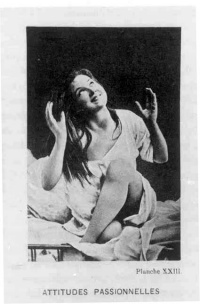Hysteria
From The Art and Popular Culture Encyclopedia
|
"We are all hysterics, since Charcot, that grand priest of hysterics, that breeder of chamber hysterics, maintains in his model establishment the Salpêtrière at great expense a number of nervous women among whom he inoculates madness and of whom he makes demoniacs in no time. One needs to be very ordinary, very common, very reasonable to not be classed among hysterics." --"Une femme" (1882) by Guy de Maupassant "The question that first presents itself, after pronouncing the word hysteria, and when a person has already some knowledge of the phenomena of the disease, is this, videlicet, is it hysteria ? that is to say, has the womb anything to do with it ? and if the womb has anything to do with it, can a man, who has no womb at all, have hysteria ? "--Females and Their Diseases; A Series of Letters to His Class (1848) by Charles Delucena Meigs |

|
Related e |
|
Featured: |
Hysteria, in its colloquial use, describes unmanageable emotional excesses. People who are "hysterical" often lose self-control due to an overwhelming fear that may be caused by multiple events in one's past that involved some sort of severe conflict.
Generally, modern medical professionals have given up the use of "hysteria" as a diagnostic category, replacing it with more precisely defined categories such as somatization disorder. In 1980, the American Psychiatric Association officially changed the diagnosis of "hysterical neurosis, conversion type" to "conversion disorder".
Because of its association with female hysteria the term hysteria fell out of favor in the latter half of the 20th century. The word "hysterical" was replaced with synonyms such as functional, nonorganic, psychogenic and medically unexplained. In 1980 the American Psychiatric Association officially changed the diagnosis of “hysterical neurosis, conversion type” to “conversion disorder.”
History
In the Western world, until the seventeenth century, hysteria referred to a medical condition thought to be particular to women and caused by disturbances of the uterus (from the Greek ὑστέρα "hystera" = uterus). The origin of the term hysteria is commonly attributed to Hippocrates, even though the term isn't used in the writings that are collectively known as the Hippocratic corpus. The Hippocratic corpus refer to a variety of illness symptoms, such as suffocation and Heracles' disease, that were supposedly caused by the movement of a woman's uterus to various locations within her body as it became light and dry due to a lack of bodily fluids. One passage recommends pregnancy to cure such symptoms, ostensibly because intercourse will "moisten" the womb and facilitate blood circulation within the body.
By the mid to late 19th century, hysteria (or sometimes female hysteria) came to refer to what is today generally considered to be sexual dysfunction. Typical treatment was massage of the patient's genitalia by the physician and, later, by vibrators or water sprays to cause orgasm.
A more modern understanding of hysteria as a psychological disorder was advanced by the work of Jean-Martin Charcot, a French neurologist. In his 1893 obituary of Charcot, Sigmund Freud attributed the rehabilitation of hysteria as a topic for scientific study to the positive attention generated by Charcot’s neuropathological investigations of hysteria during the last ten years of his life. Freud questioned Charcot’s claim that heredity is the unique cause of hysteria, but he lauded his innovative clinical use of hypnosis to demonstrate how hysterical paralysis could result from psychological factors produced by non-organic traumas (psychological factors that Charcot believed could be simulated through hypnosis). To Freud, this discovery allowed subsequent investigators such as Pierre Janet and Josef Breuer to develop new theories of hysteria that were essentially similar to the medieval conception of a split consciousness, but with the non-scientific terminology of demonic possession replaced with modern psychological concepts.
In the early 1890s Freud published a series of articles on hysteria which popularized Charcot's earlier work and begun the development of his own views of hysteria. By the 1920s Freud's theory was influential in Britain and the USA. The Freudian psychoanalytic school of psychology uses its own, somewhat controversial, ways to treat hysteria. Freudian psychoanalytic theory attributed hysterical symptoms to the subconscious mind's attempt to protect the patient from psychic stress. Subconscious motives include primary gain, in which the symptom directly relieves the stress (as when a patient coughs to release energy pent up from keeping a secret), and secondary gain, in which the symptom provides an independent advantage, such as staying home from a hated job. More recent critics have noted the possibility of tertiary gain, when a patient is induced subconsciously to display a symptom because of the desires of others (as when a controlling husband enjoys the docility of his sick wife). There need be no gain at all, however, in a hysterical symptom. A child playing hockey may fall and for several hours believe he is unable to move, because he has recently heard of a famous hockey player who fell and broke his neck.
Many now consider hysteria to be a legacy diagnosis (i.e., a catch-all junk diagnosis), particularly due to its long list of possible manifestations: one Victorian physician cataloged 75 pages of possible symptoms of hysteria and called the list incomplete.
References
- Ilza Veith: Hysteria: The History of a Disease The University of Chicago Press 1965
- Huberman: Invention of Hysteria (1982)
See also
- Studies on Hysteria (Sigmund Freud with Josef Breuer)
- Histrionic Personality Disorder
- Female hysteria
- Hysterical contagion
- Mass hysteria
- Hysteria (2011 film)

